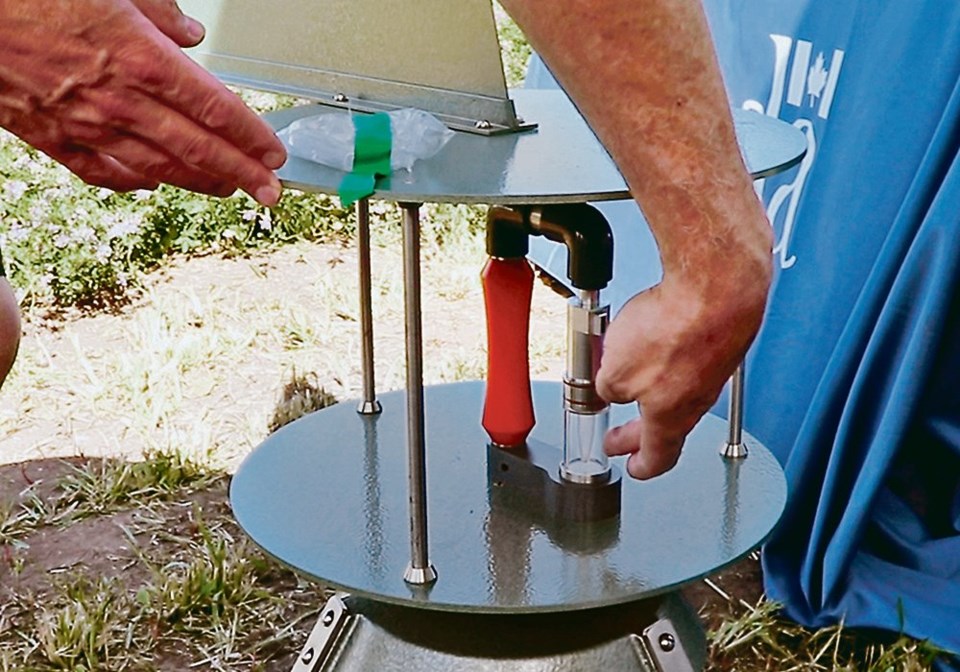LANGHAM, Sask. — Researchers at the Agriculture Canada research centre in Saskatoon are developing molecular diagnostic assays to detect significant pathogens associated with crops and livestock production.
Biological assays are methods for assessing the presence, localization, or biological activity of a substance in living cells and biological matter.
Tim Dumonceaux of Ag Canada said many pathogens are important for crop and animal production. Pathogens they develop assays for depend on the economic impact they have on farms.
We “develop and validate the assays and the model that we followed to make them available to producers is using a licensing approach, not so much a patent approach,” Dumonceaux said during the Ag In Motion farm show held at Langham July 19-21.
“This is so that companies can pick up the assays and offer them to the producers and package it in a way that will be relevant to them.”
Once the assay is produced and verified, companies can build technology that uses the result of a positive or negative result with the assay to help farmers make management decisions.
Dumonceaux said systems that use these assays to test samples for the specific pathogens can be simple to use with little training and can be conducted in the field or barn.
At Ag In Motion, Ag Canada displayed a few methods of using the assays to see if the DNA of a pathogen is present in a sample.
Visitors to the Ag Canada booth could take samples from an air sampler to test if there were signs of sclerotinia in the air.
The samples were put in an assay and visitors could choose from three separate methods of finding out if sclerotinia DNA was in the sample.
There was a low technology method of DNA extraction where samples were placed in vial with the assay and if the solution changes color it indicated sclerotinia was present.
There were also more complicated solutions where a sample is placed in a machine that indicated if the target pathogen is present, and an even more advanced machine that sequenced all the DNA present in a sample.
Dumonceaux said sampling strategies will vary depending on which pathogen is being investigated.
For instance, if a grower wanted to find out if fungi is present in their stored grain, it’s possible to develop an assay and sampling technique that can detect the fungi before any visual signs are present.
“You could do something like wash the outside of the seed with you know, a buffer with the light detergent in it to knock off whatever organisms are associated with seeds. We’ve done that in the past to get the bacteria and fungi that are associated with the seeds and you can detect pathogens in that way,” Dumonceaux said.
Plant tissue can also be tested, a strategy Dumonceaux used in his study into blueberry diseases in Quebec.
This study used these same molecular techniques to develop assays for blueberry stunt disease that’s caused by a phytoplasma, which is closely related to the bacterium that causes the aster yellows disease seen in canola.
Dumonceaux said it’s possible to monitor the geographic distribution and spread of the pathogen in blueberry production fields, as well as the movement of the pathogen within and among plants.
“We use leaf samples from the actual plant itself. So, you clip the leaf off the plant and you can do the DNA extraction there in the field, and then you can do the actual detection assay and get the results back in just a few minutes,” Dumonceaux said.
“We think it can work for other diseases as well.”
A separate display at the Ag Canada booth featured a project by Tara Funk that uses the same molecular techniques but to detect bovine respiratory disease in cattle (BRD), also known as shipping fever.
Funk is a PhD student at the Western College of Veterinary Medicine at the University of Saskatchewan, and she said BRD costs the beef industry in North America between US$800,000 to $900,000 every year.
“I’m doing something called recombinase polymerase amplification (RPA) on samples that we take from beef cattle on arrival at a feedlot. What we’re trying to do is develop these tests to identify bacteria assistance primers that we apply to the samples and specialize enzymes,” Funk said.
This test provides results about 30 minutes after nasal swabs are taken from cattle. It detects bacteria and pathogens with antibiotic resistance.
“The machine is very straightforward. What it does is it provides us with the information that we can get to producers and veterinarians on how to make an educated choice on the antibiotic that they might use,” Funk said.




